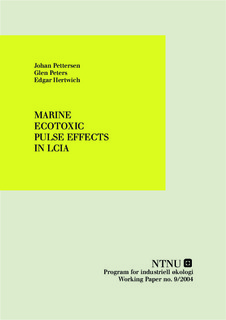| dc.contributor.author | Pettersen, Johan | nb_NO |
| dc.contributor.author | Peters, Glen | nb_NO |
| dc.contributor.author | Hertwich, Edgar | nb_NO |
| dc.date.accessioned | 2014-12-19T12:34:44Z | |
| dc.date.available | 2014-12-19T12:34:44Z | |
| dc.date.created | 2007-01-18 | nb_NO |
| dc.date.issued | 2004 | nb_NO |
| dc.identifier | 121815 | nb_NO |
| dc.identifier.uri | http://hdl.handle.net/11250/242573 | |
| dc.description.abstract | Fate modeling for characterization of ecotoxic substances in life-cycle impact assessment (LCIA) is traditionally performed with steady-state multi-compartment models. Instantaneous mixing within compartments is an implicit assumption of the multi-compartment model. Others have shown that steady-state models can account for pulse-exposure if the ecotoxic effect is calculated with a constant effect factor. The potentially affected fraction of species (PAF) has previously been used to derive ecotoxic effect factors. Time and space variant dispersion models (transient models) are used in marine ecological risk assessments for aquatic exposure from intermittent marine discharges. Transient models can implement continuous effect functions in pulse-exposure assessment. In this paper the significance of assuming constant effect factors is quantified by calculation of characterization factors for marine aquatic ecotoxicity with a transient dispersion model. Multi-substance PAF (msPAF) is used as definition of ecotoxic effect. Results show that for characterization factors with msPAF assuming concentration addition only, the deviation between a constant effect factor and a continuous effect function is small. This implies that pulse-effects are well handled with the traditional approach of approximating effect with constant effect factors. For msPAF defined with a combination of response and concentration addition, the deviation can be several orders of magnitude. | nb_NO |
| dc.language | eng | nb_NO |
| dc.publisher | Program for industriell økologi | nb_NO |
| dc.relation.ispartofseries | Working Papers from Industrial Ecology Programmme (IndEcol), 1504-3681; 2004:9 | nb_NO |
| dc.subject | Life cycle impact assessment | en_GB |
| dc.subject | Ecotoxicity | en_GB |
| dc.subject | Pulse | en_GB |
| dc.subject | Transient | en_GB |
| dc.subject | Fate | en_GB |
| dc.title | Marine Ecotoxic Pulse Effects In LCIA, | nb_NO |
| dc.type | Research report | nb_NO |
| dc.contributor.department | Norges teknisk-naturvitenskapelige universitet, Fakultet for ingeniørvitenskap og teknologi, Program for industriell økologi | nb_NO |
